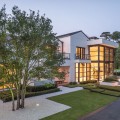Contemporary Garden Design

Contemporary garden design is one of the most unique and innovative styles you will ever experience in the world of gardening.
Contemporary gardens are powerfully distinguished by clean lines, sharp, unpredictable angles, and unique geometric forms. Contemporary garden design itself is highly subjective and varies greatly between projects. This is because any type of modern landscape design is highly personalized to the individualized homeowner in such a way that no two contemporary gardens ever look quite the same.
It is always better to hire a professional who has experience in contemporary garden design than to attempt to build one yourself. Professional landscapers know how to balance the practicalities of residential landscape design with highly personalized landscape elements. For example your garden may be the most unique expression of your soul on your landscape, but it still has to work with your house, your patio, your collection of outdoor art, and your contemporary custom fountain.
Also, a contemporary garden is simply not going to work in a yard that lacks contemporary landscape design itself. You need the guidance of a professional to create one of these gardens, and the structure of a master plan to make it work for your property and add curb appeal to your home.
First and foremost, your contemporary garden should be designed for low maintenance. Houston professionals are busy, so it is not practical to have a garden built that you will have to take care of daily. Vegetation must be minimal, slow growing, and rugged enough to take care of itself.
A minimalist treatment of vegetation will also contribute to the mentalist nature of your contemporary garden design. The human ego is always seeking to project its own form onto the world. This is why so many traditional landscapes use the same motifs over and over again. The sensory appeal creates a comfort zone of familiarity that makes a person feel safe and accepted. This is all basic psychology, and it all goes into the recycling bin the minute you step onto a contemporary landscape.
Here, the gardens and other landscape elements are going to challenge your mind by defying the expectations of your senses. Colors that normally go with certain shapes will be absent in some and present in others. Vegetation, which is considered a universal of gardening, is actually limited and confined to smaller areas and deliberately subordinated to hardscapes and masonry.
Nothing ever stands still in a contemporary garden, either. The design is meant to move your eye through the garden and on to other forms. This may involve actually inviting you to walk a path through the form, or it may simply be an optical trick that moves your vision to a new point of interest.
Hardscapes are therefore built to always support a sense of movement. Pavers are very popular because they can be obtained in all shapes, sizes, and colors and interlocked in such a way as to create visual patterns of movement and actual walkways. Some look like stepping stone, while others look like bricks. The size of the stones and the direction(s) they point to all depend on the size of your property and what other features distinguish its landscape.
Special materials are also routinely used in contemporary garden design. This is to create the sense of individuation so important to this form. As previously noted, organic life is minimized in relation to human structures. In addition to pavers, patios, and masonry walls, garden design teams also use innovative materials such as opaque and colored glass walls, mirrors, stainless steel posts that support hanging baskets of small exotic plants, and even artificial turf to suggest organic life rather than directly experience it.




